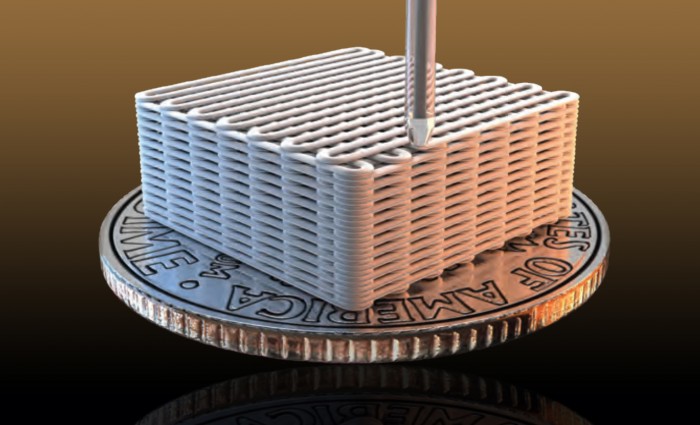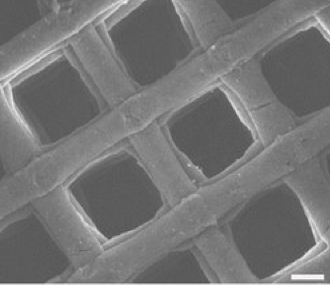3D-printed aerogels enable new energy-storage and nanoelectronic devices
May 15, 2015

Lawrence Livermore researchers have made graphene aerogel microlattices with an engineered architecture via a 3D printing technique known as direct ink writing (credit: Ryan Chen/LLNL)
Lawrence Livermore National Laboratory researchers have made novel graphene aerogel microlattices with an engineered architecture, using a 3D printing technique known as “direct ink writing.” The research, which could lead to better energy storage, sensors, nanoelectronics, catalysis, and separations, is described in an open-access paper in the April 22 edition of the journal Nature Communications.
Lawrence Livermore National Laboratory | How we 3D-print aerogel
The 3D printed graphene aerogels have high surface area, excellent electrical conductivity, are lightweight, have mechanical stiffness and exhibit supercompressibility (allowing for up to 90 percent compressive strain), and show a ten times improvement over bulk graphene materials and much better mass transport.
Aerogel is a synthetic porous, ultralight material derived from a gel, in which the liquid component of the gel has been replaced with a gas. It is often referred to as “liquid smoke.”
3D printing with graphene oxide (GO) inks

SEM image of a 3D printed graphene aerogel microlattice. Scale bar: 100nm. (credit: Cheng Zhu et al./Nature Communications)
The graphene oxide (GO) inks are prepared by combining an aqueous GO suspension and silica filler to form a homogenous, highly viscous ink. These GO inks are then loaded into a syringe barrel and extruded through a micronozzle to pattern 3D structures.
“Adapting the 3D printing technique to aerogels makes it possible to fabricate countless complex aerogel architectures for applications such as mechanical properties and compressibility, which has never been achieved before, ” said engineer Cheng Zhu, a co-author of the journal article.
Previous attempts at creating bulk graphene aerogels produced a largely random pore structure, excluding the ability to tailor transport and other mechanical properties of the material for specific applications such as separations, flow batteries, and pressure sensors. “Making graphene aerogels with tailored macro-architectures for specific applications with a controllable and scalable assembly method remains a significant challenge that we were able to tackle,” said engineer Marcus Worsley, a co-author of the paper.
In contrast, “3D printing allows for intelligently designing the pore structure of the aerogel, permitting control over mass transport (aerogels typically require high pressure gradients to drive mass transport through them due to small, tortuous pore structure) and optimization of physical properties, such as stiffness,” he said. “This development should open up the design space for using aerogels in novel and creative applications.”
The work is funded by the Laboratory Directed Research and Development Program.
Abstract of Highly compressible 3D periodic graphene aerogel microlattices
Graphene is a two-dimensional material that offers a unique combination of low density, exceptional mechanical properties, large surface area and excellent electrical conductivity. Recent progress has produced bulk 3D assemblies of graphene, such as graphene aerogels, but they possess purely stochastic porous networks, which limit their performance compared with the potential of an engineered architecture. Here we report the fabrication of periodic graphene aerogel microlattices, possessing an engineered architecture via a 3D printing technique known as direct ink writing. The 3D printed graphene aerogels are lightweight, highly conductive and exhibit supercompressibility (up to 90% compressive strain). Moreover, the Young’s moduli of the 3D printed graphene aerogels show an order of magnitude improvement over bulk graphene materials with comparable geometric density and possess large surface areas. Adapting the 3D printing technique to graphene aerogels realizes the possibility of fabricating a myriad of complex aerogel architectures for a broad range of applications.